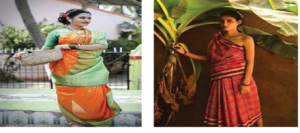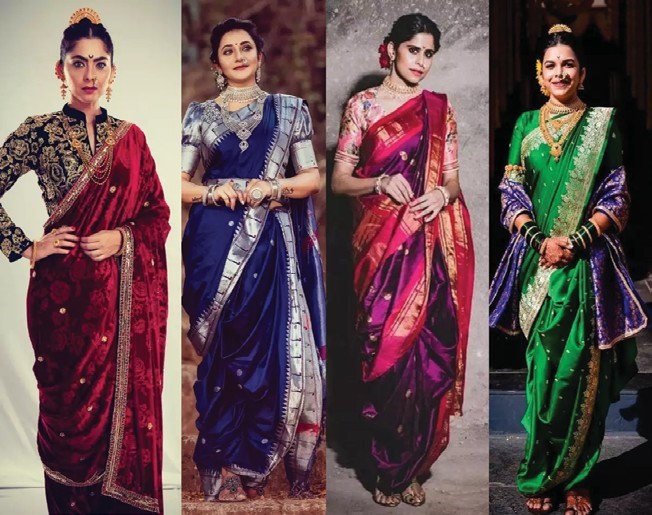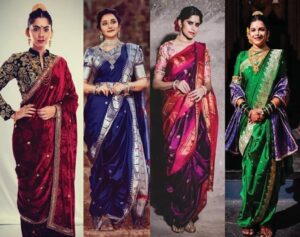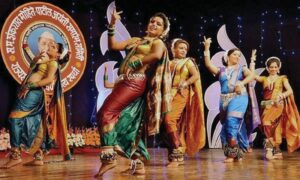The third-largest state by area in India, Maharashtra is a true blend of traditional and modern living. A region known to preserve its culture and whose people are known to uphold traditional values and rituals, Maharashtra is very rich in terms of the traditional attire especially the saree. Maharashtrian women commonly wear the saree, like in most parts of India, but that is draped in a modern, more convenient and practical manner for daily wear.
Earlier, women in Maharashtra would wear the traditional Nauvari saree that were also designed for specific occasions, according to the prevailing local culture and customs. Today, the Nauvari is mostly worn on special occasions, festivals such as Ganesh Chaturthi, Gudi Padwa, etc., and during wedding ceremonies.
The distinct saree of Maharashtra is the Nauvari saree which means the nine-yard-long saree. Even in popular culture, such as in films and other visual mediums of art, a Maharashtrian woman can be easily identified because of the Nauvari saree and, concurrently, the Nauvari saree is used to depict a woman as one belonging to this region.

Draped in history
The Nauvari saree can be draped like a ‘kacham’ or like a ‘dhoti’. This distinctive piece of clothing, a Maratha woman’s apparel, is a single cloth nine yards in length and hence the name Nauvari. It is also called Navvari, Kacha, Sakacha, Lugade or Kaashta saree, because the manner in which it is draped or worn is similar to that of a Maharashtrian dhoti.
This saree was customarily worn by venerable Marathi women and Maharashtrian Brahmin women, accessorised with gold jewellery that includes gold necklace, nose pin or nath, earrings, green bangles and kamarband – derived from Maratha and Peshwa dynasties.
The Maharashtrian women, owing to their love for flowers, also put mogra flowers or gajra in their hair, around the low-buns. The look is further accessorised with the traditional half-moon style Bindi.
It is said that during the Maratha rule, in war time, the women, in order to showcase and strengthen their physical skills and abilities, developed this saree draping style that is like a dhoti. At the time, the women, to help the men of their family in battle, introduced the Nauvari saree that resembles a trouser making it convenient and suitable for the war-time chores then. Since then, however, it became traditional attire for the Maharashtrian women. The women of the royal families wore this saree and it was a mark of royalty.
Variations and styles
Nauvari sarees were originally made from cotton and worn without a petticoat. Even today, they normally come in cotton but are readily available in other textiles like silk and satin. Traditional nauvari sarees are embellished with beautiful floral prints, motifs and patterns.
The Nauvari saree of Maharashtra is draped in unique styles that have, over time, diversified into various sub-styles – according to the sub-group, community, topography, occupation, etc. Even the colours have evolved from the traditional variations of blue and green to bright colours like red, pink, orange, yellow even the pastels to fulfil contemporary demands.
The Kaashta saree is draped like the Maharashtrian dhoti where the saree is tucked at the back, hence the name Kaashta. The traditional Maharashtrian drape style doesn’t require a petticoat and that’s one thing common across all the different types of Nauvari saree.
There are many variations seen across Maharashtra. For example, the Peshwai Marathi saree is strictly worn by the Brahmin women who also wear it in a certain manner to depict their rich heritage and take pride in it. The draping style here is called the Brahmini Saree Style where the saree is draped just like the traditional Nauvari saree, the only difference being the front pleats. The border of the saree is displayed on the front side as well, in addition to the back side like in the kashta.
The Koli women drape this saree in a different style. They cut it into two pieces – one piece is worn around the waist and the other piece is used to cover the upper part of the body. The cloth is then taken over the head, around the left shoulder in the traditional manner.
In Maharashtra’s Konkan, the women of the native Aagri community wear the saree till the knee. Called the ‘adwa patal’, this style is worn by the Aagri women and bears close
resemblance to the style draped by the women of the farming Kunbi community, especially in Raigad and Ratnagiri areas of Maharashtra.
The Kunbi women also wear the nine yard saree and it’s called ‘uprati’ which means upside down, because the folds of the saree are upside down as compared to the traditional style. The women in the interiors of Maharashtra, in rural Ahmednagar, Kolhapur, Satara and Pune wear the saree till the ankles.
Keeping up with the times
Maharashtrian women performing lavani or traditional folk dance of Maharashtra wear the lavani nine-yard saree. They, typically, make their hair in a bun and wear a lot of jewellery that includes bormaal, zumka or earrings, thushi or necklace, bangles, kamarpatta or waist belt and ghungru.
The older women usually wear the five-yard saree. The Paithani five-yard saree is worn by younger women and also mostly by those in urban areas. Paithani is a hand-woven silk saree which has an intricate zari work, pallu and border. The unique saree is characterised by borders of an oblique square design and the pallu with a peacock design.
‘Paithani’ term indicates the origin of the saree – derived from Paithan near Aurangabad in Maharashtra, one of the oldest towns of the region. Paithani work is more than two thousand years old, originating in Pratishthan that was ruled by the Satavahanas ruler Shalivahana, now called Paithan in Marathwada region.
Owing to patronage from the Peshwas, the Paithani textiles developed and reached far and wide. There are several motifs used in the design, the oldest being vine and flowers (asavali), squarish floral motifs (akruti), petals (kalas pakli), fan (pankha), cocount (narali) and cotton bud (rui phul).
Over the years, Paithani too, like most other traditional attire, evolved from a cotton base to a silk base. In fact, in most Paithani sarees, silk is used in weft designs and borders and cotton comprises the main body of the cloth. In some, cotton is not used at all.
In Pune, readymade Nauvari sarees are available that have a mixed style of draping and are very popular among women. The Nauvari saree designs available today include Shahi Mastani, Shahi Brahmani, Mhalsa, Devsena, Devyani, Peshwai Brahmani, Kolhapuri, Kadambari, Lavani, Triveni, Mastani, Koli, Marathmoli, Fulwanti, etc.
The traditional nine-year Nauvari saree that was once very popular is now restricted to special occasions only. Today, most women in Maharashtra are wearing modern clothing and the Nauvari saree is either worn on festivals or bought as offerings to goddesses or used during wedding ceremonies.
Designers are trying to keep up with the times as women want to wear something that is convenient and quick and usually offered by modern attire such as skirts, trousers, shirts even salwar-kameez.
In order to keep the tradition alive and combining elegance with convenience, designers have created the ready-made nauvaris, that too, for women of all age groups. Going a step further, there are outlets where one can choose the nauvari of choice and the seller or the designer then stitches it into a ready-to-wear pyjama-cum-saree.


 Marathi actresses and their traditional Nauvari looks on Gudi Padwa
Marathi actresses and their traditional Nauvari looks on Gudi Padwa Maharashtrian women performing lavani or traditional folk dance of Maharashtra wear the nine-yard saree. They, typically,make their hair in a bun and wear a lot of jewellery that includes bormaal,
Maharashtrian women performing lavani or traditional folk dance of Maharashtra wear the nine-yard saree. They, typically,make their hair in a bun and wear a lot of jewellery that includes bormaal,